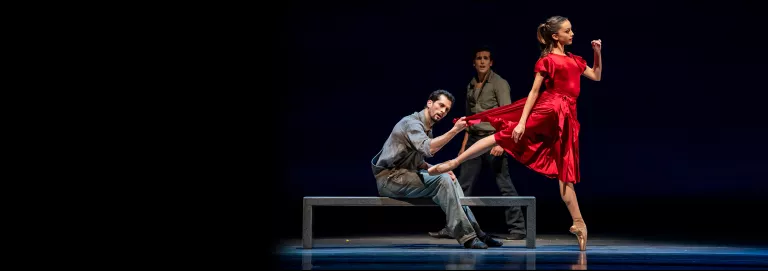
Captioning
Program:
Serenade
Of Mice and Men
The Times Are Racing
The Joffrey Ballet returns to Northrop with a dynamic program of three works: Serenade—the first ballet George Balanchine created in America in 1934, an electric “sneaker ballet” from Tony Award winner Justin Peck, and the Northrop Centennial Commission Of Mice and Men adapted by choreographer Cathy Marston. This new take on John Steinbeck’s tender tale of friendship, perseverance, and sacrifice features an original score by 14-time Academy Award nominee, Thomas Newman (The Shawshank Redemption, Skyfall, Finding Nemo), played live by Northrop’s Ballet Orchestra.
Advisory:
This production Of Mice and Men includes the use of a prop gun and a gunshot sound effect.
“Marston’s terrific choreography is a spectacular blend of rough and tumble Americana and elegant ballet technique.” —Chicago Tribune
“There is something eminently satisfying and reassuring about watching [Serenade], where every gesture, every step feels just right. That is a definition of a classic, which this work most definitely is.” —Chicago Sun-Times
“The one greatest takeaway from the program is that the Joffrey dancers are not just sublime dancers but also exceptionally skillful actors who invariably turn movement into a powerful form of speech.” —WTTW (PBS) Chicago
The content below derives from the Northrop Across Campus Program that supports Northrop's mission towards intersections between performing arts and education for the benefit of all participants now and for generations to come.
Find ways to make thematic connections to these suggested topics:
Take a deeper dive with these resources that provide additional information about the performers, the history of the artform, and the artistic process.
The Joffrey Ballet – Company website
Cathy Marston – Artist website
La Jolla Music Society – Joffrey Ballet Brings a Program of New Dance Styles
Sparknotes – Of Mice and Men – Study Guide
WTTW Chicago – Joffrey Ballet’s Of Mice and Men Shifts Focus of Tragic Story
Chicago Tribune – Review – The Joffrey brings Of Mice and Men to the ballet stage in a world premiere: plus Balanchine’s Serenade – Find in the U of M Library
Start a conversation about the performance, or encourage reflection, using these questions as inspiration.
Cathy Martson’s work as a choreographer gives new perspectives to old narratives. She is known for merging classical and contemporary art forms, reconciling discord with grace, and blending expressive integrity with technical quality as seen in her most recent creation, Of Mice and Men.
Of Mice and Men demonstrates a story about friendship, perseverance, and sacrifice. In an interview with The Guardian, Marston was asked if she believed that all art was political, to which she replied, “No. I'm more interested in our inner worlds - our emotions and relationships - than in politics. But that could change.”
According to a Chicago Tribune review, “Marston has long lusted after the British literary canon. She created ballets from Wuthering Heights and Jane Eyre—the latter performed by Joffrey in 2019. The shift to American literature marks her first original ballet for Joffrey. In Of Mice and Men, Marston collaborates with 14-time Academy Award nominated composer, Thomas Newman, who created an original score for the ballet.
The Joffrey Ballet program will also feature Serenade, a 1935 ballet originally choreographed by Georgian-American, “father of American ballet,” George Balanchine. This was the first ballet he created in America. The George Balanchine Trust is known for its careful and detailed preservation of Balanchine ballets, which are often taught to dancers by rehearsal directors who previously performed the ballet.
This activity is made possible by the voters of Minnesota through a Minnesota State Arts Board Operating Support grant, thanks to a legislative appropriation from the Arts and Cultural Heritage Fund.
This project is supported in part by the National Endowment for the Arts. To find out more about how National Endowment for the Arts grants impact individuals and communities, visit www.arts.gov.